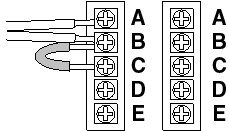-
What is a strain gauge?
This type of sensor measures the slight elongation and contraction of an object. It has a resolution of 1/1,000,000. Changes in electric resistance are used. Most are attached directly to the object with an adhesive. Strain gauges for room temperature can measure up to +80℃. For adhered high-temperature applications, the temperature can be up to +350℃.
* At higher temperatures, some are attached by electric welding and can measure up to +800℃. -
What is the gauge factor?
The constant (K) of the resistance change between the strain and the strain gauge, and is unique for each production lot. It is expressed by the relationship
ε = ΔL/L = (ΔR/R)/K
ε: strain, ΔL: displacement due to external force, L: original length of object, ΔR: resistance change of strain gauge, R: strain gauge resistance value, K: gauge factor -
How do you correct the gauge factor?
Multiply the measured value by the value of "2/K (gauge factor)".
For example,
For a strain gauge with a gauge factor (GAUGE FACTOR) of 2.13
Multiply the measured value by 2/2.13 = 0.939.
(2 is the gauge factor set for the instrument) -
What is the gauge length?
The effective length of the strain gauge sensor in the measurement axis direction is measured by averaging the strain generated along this length. The gauge length is short for spot measurements, and the gauge length is long to obtain the average characteristics of a composite material when measuring such material. In the case of concrete, use a gauge with a length of three times or more that of the aggregate.
-
What is the thermal output of a strain gauge?
In general, when a strain gauge is adhered to a specimen, even if there is no strain due to an external force, when the temperature of the test specimen changes, the coefficient of thermal expansion of the specimen causes apparent strain, which is accompanied by a change in resistance. At the same time, the temperature coefficient of resistance of the gauge sensor material causes a change in resistance. This is called "thermal output" (apparent strain due to temperature).
For example,
Assuming that the specimen freely expands due to temperature changesεT = (α/K) ΔT + (βs−βg) ΔT
Where
α: Temperature coefficient of resistance of the gauge sensor
βs: Coefficient of thermal expansion of the specimen
βg: Coefficient of thermal expansion of the gauge sensor
ΔT: Temperature change
K: Gauge factor
εT: Thermal outputWe manufacture self temperature compensated strain gauges with which the temperature coefficient of resistance α is adjusted so that the thermal output εT becomes zero, having taken into account βs and βg.
Since βs, βg, and α are not constants, εT cannot constantly be set to zero, and εT is adjusted to a minimum value within a certain temperature range. -
What is a self temperature compensated strain gauge?
A strain gauge is designed so that its thermal output is as little as possible when it is adhered to a specimen having a specific coefficient of thermal expansion within a specified temperature range.
We term a gauge of within ±1.8 × 10−6 strain per 1℃ capability a self temperature compensated gauge. -
Please describe how to correct the thermal output of a strain gauge.
To correct the thermaloutput, use the approximate expression for thermal output in the data sheet included with the strain gauge. Substitute the measured temperature (T1) for the term "T" in the approximate expression and to obtain the thermal output at that temperature. Substitute the temperature at the start of measurement (T0) for the term "T" in the approximate expression to obtain the thermal output at that temperature, and their difference (T1 − T0) is thermal output using the start of measurement as a reference. Correction of thermal output is therefore is the subtraction of that value from the measurement result.
-
What is quarter bridge 3-wire method?
If the extended lead wire attached to the strain gauge is affected by the temperature, output will be generated due to temperature in the case of 2 wires, but output will not be generated even if there is a temperature effect in the case of the quarter bridge 3-wire method. If there is a change in temperature during measurement, use the quarter bridge 3-wire method.
-
What is the 1-gauge 4-wire method?
This is a measurement method that completely compensates for any effect by the lead wire in measurement using a quarter bridge method.
It is unnecessary to correct any gauge factor change due to an extension of the lead wire or to correct any temperature effect of the lead wire.
In addition, the one-touch connection by a modular plug is possible, and there is no troublesome work due to wiring in the right order of soldering.
Instruments that can be used include data loggers TDS-630, TDS-540, TDS-150, TC-32K, switching boxes SSW-50D, ISW-50G, IHW-50G, IHW-50H, and FSW-10. -
Can strain gauges for aluminum be used for magnesium alloys?
Aluminum has a coefficient of thermal expansion of 23 × 10-6/℃ and magnesium has a coefficient of thermal expansion of 26 × 10-6/℃, which are almost the same. Therefore, the product can be used without any problems under conditions where temperature is constant and does not change during measurement.
-
Does the strain gauge have a front and back?
The strain gauge has a resistor on the backing, and the front of the strain gauge is easy to discern with the resistor. The gauge leads are soldered to the tabs, so the side where they are soldered on is the front. In addition, a TML mark or, depending on the type, a number indicating the number of gauge axes, is indicated on the front side.

For the strain gauges of the polyester-backing PF and P series, the side on which the TML mark, model name, and the number indicating the gauge length can be read correctly is the front.

When adhering a strain gauge, apply adhesive to the back of the strain gauge and attach it to the object to be measured.
-
Is it possible to measure by quarter bridge 2-wire method with a static strainmeter?
It is possible. However, you must short-circuit the terminals B and C and set the strainmeter to the quarter bridge 3-wire method for measurement.

-
Can strain gauges be adhered to plastic materials?
Some materials can be adhered as they are, some can be adhered to after pretreatment, and some cannot be measured even if a gauge can be adhered to them, because their elastic modulus is low and the strain sensitivity is insufficient. See this list.
Abbreviation Name of plastic Measurement determination ABS Acrylonitrile butadiene styrene 
CR Chloroprene rubber (neoprene) - EP Epoxy resin 
FRP Glass fiber reinforced plastic 
NR Natural rubber - PA 66 nylon 
PC Polycarbonate 
PE Polyethylene Δ PET Polyethylene terephthalate Δ PI Polyimide 
PMMA Polymethyl methacrylate (acrylic) 
PP Polypropylene Δ PS Polystyrene (styrol) 
PTFE Polytetrafluoroethylene (fluorinated resin) Δ PU Polyurethane - PVC Polyvinyl chloride (hard) 
SI Silicone - UP Unsaturated polyester 
Measurement rating
 : Adherable and measurable without treatment
: Adherable and measurable without treatment
Δ: Adhesion requires pretreatment; measurable
-: Non-adherable, low elastic modulus, measurement not possible -
How many times can an adhesive strain gauge be used?
Adhesive-type strain gauges that can measure at up to 350℃ and adhesives are available. Weldable strain gauges are used for strain measurement exceeding 350℃. A weldable strain gauge can be welded with the spot welder (W-50RC) and measure at up to 800℃.
-
How long does a strain gauge last when measuring repeatedly, as in a fatigue test?
Strain gauges are tested for fatigue life in accordance with the “Test Standard NAS942”. General-purpose gauges have a life span of 1 x 106 or more at strain levels of ±1500 x 10-6. The special strain gauge DSF series with more durability is also available.
-
Can a strain gauge be adhered and used for measurement with a commercial adhesive?
We have confirmed satisfaction of gauge characteristics by our adhesives especially for strain gauges, with no occurrence of creep with a strain gauge. Since no confirmation has been made with commercially available adhesives, their use is not recommended.

Tokyo Measuring Instruments Laboratory Co., Ltd.
- Headquarters
- 8-2, Minami-Ohi 6-chome,
Shinagawa-ku, Tokyo 140-8560
Japan - TEL:+81-3-3763-5614

